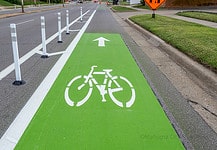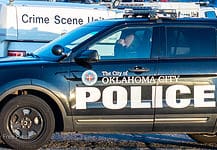Last Updated on October 9, 2022, 8:59 AM | Published: October 9, 2022
The animated stoplight on the Oklahoma Highway Safety website is flashing a green light, indicating that traffic related deaths in the state are currently down from this same time last year, but that’s only telling a part of the full story.
Though this year’s Oklahoma City numbers are on track to come in at least slightly under 2021’s final totals, a look at the categorized breakdown of the city’s traffic fatalities shows a worrying trend:
The number of pedestrian deaths in traffic incidents in OKC is consistently among the very highest in the data, at best coming in second only behind multiple-car accidents, and at worst actually matching that number for the most deadly category.

According to traffic fatality numbers acquired from the Oklahoma City Police Department, the only recent year in which multi-car accident deaths far exceeded pedestrian deaths was 2021, when car use and traffic of all kinds saw a marked spike following 2020’s COVID-19 distancing and statewide shutdowns.
So far this year, as was the case throughout the entirety of 2020, pedestrian death numbers have run almost perfectly parallel to multi-car accident deaths in OKC – with both categories at 19 deaths as of October 5th – raising questions about how streets can be made safer and how urban “walkability” might be improved.
“An afterthought”
As president of the Uptown 23rd District Association, and Ward 2’s official representative for the Citizens Committee for Community Development, Chelsea Banks spends a lot of time thinking of ways to improve safety and accessibility for OKC pedestrians.
“Pedestrian safety is an afterthought in Oklahoma City,” Banks told me. “I walk as much as I can, but I still have a car and I still use my car almost every day. The way that our city is spread out, we obviously need to have cars just because of how the infrastructure is oriented. It’s very much oriented towards car traffic in general.”

In looking at ways that the city’s infrastructure and street planning could be reconsidered to prioritize foot traffic and walking safety, Banks has taken cues from other urban centers around the country.
“There are a lot of different cities that employ things like bump-outs and leading pedestrian intervals,” she said. “And these are just small changes. A bump-out would be a kind of large curve, usually at an intersection, that provides some sort of blocking between the car traffic and the humans on the sidewalks. Leading pedestrian intervals would be programming in a four-second interval whenever you push the crosswalk sign, so the lights for the cars don’t activate for four full seconds. Some places even have them up to ten seconds, so Oklahoma City still has long way to go.”
First-hand account
For Banks, the understanding of the risks and potential dangers of the city’s car-oriented infrastructure is much more than anecdotal.
In August 2020, she was hit by a car while attempting to cross the intersection of NW 23rd and Walker on foot.
“This is a street that I cross all the time, and we walk my son through this intersection to go to school,” she said. “This is a very familiar place for me, and as we were crossing the street, there was a driver in a car turning left that did not yield to us. If it hadn’t been for myself and my husband just noticing and watching that happen, I probably I would not be here, because she just came through the intersection having no regard for the fact that there could be a human there at all.”

Banks was lucky to sustain only minor injuries – with some lingering damage to her arm – but it was enough to make it clear that measures needed to be taken. Shortly after, a leading pedestrian interval of four seconds was added to the stop lights at that intersection.
“At the end of the day,” she said, “what I feel in this situation is that we’re so distracted and we’re so preoccupied just driving a motorized vehicle that our streets currently are not optimized to do anything except for to get you from point A to point B.”
That mentality could be changing soon for 23rd Street, however, as the district is set to see a major road renovation in 2023, the result of a 2017 bond initiative designed to widen sidewalks, increase walkability, reduce street parking, and remove medians, a move shown to help promote driver awareness.
Walkability score
The nationwide website Walk Score (a part of the Redfin real estate platform) applies a weighted numerical rating to cities based on the ease and safety of foot traffic for things like errands, commuting, and outdoor recreation. This measure of “walkability” has become an increasingly popular selling point for urban areas, particularly among younger residents.
Out of a possible 100 points, OKC is currently given a “Walk Score” of just 34, and is ranked as low as 44th in a listing of large cities across the country.
The only OKC neighborhoods to receive a walkability score of more than 80 are currently the Paseo, Mesta Park, and the Corridor South area of Classen between NW 30th and NW 36th.
OKC’s “Walk Score” of 34 still dwarfs the city’s “Transit Score,” looking at public transportation options throughout the city, which is currently at a dismally low 17.
“As the city is growing and changing, we’re going to have more and more people looking for multimodal access,” Banks said, examining the primarily car-centric infrastructure that currently defines OKC. “It’s not a crazy thought that as the city expands and grows, more people are not going to have cars or they’re just not going to want that lifestyle.”
Brett Fieldcamp has been covering arts, entertainment, news, housing, and culture in Oklahoma for nearly 15 years, writing for several local and state publications. He’s also a musician and songwriter and holds a certification as Specialist of Spirits from The Society of Wine Educators.











